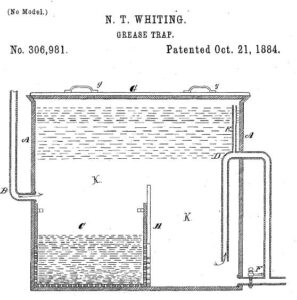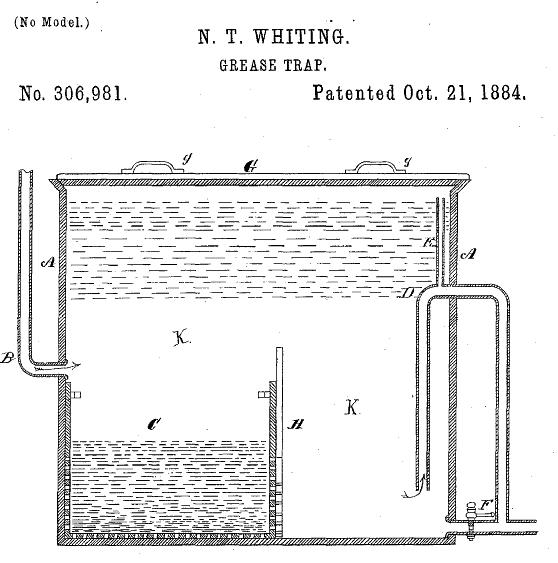Grease traps have long been used in restaurants and food processing plants to prevent fats, oils, and grease (FOG) from entering the septic tank and, eventually, the drainfield or sewer system. When properly serviced and maintained, they are very effective at reducing FOG levels in the system. Are they a candidate for residential septic systems?
FOG can wreak havoc on septic systems if allowed to enter the system unchecked. It can accumulate on the walls of pipes and tanks causing blockages and it can disrupt bacterial life, robbing the septic tank of one of its chief functions.
Grease traps have been around for over one hundred years. There are U.S. patents that date back at least to 1884 (see right).  Most grease traps operate in a manner that allows incoming wastewater to enter a “clear zone” in the grease trap. There may be one or more baffles that allow the FOG to collect at the top of the trap. The wastewater exits the trap through a baffle that has an opening at the bottom of the trap. The FOG, which remains at the top of the tank, theoretically, can never leave the trap.
Most grease traps operate in a manner that allows incoming wastewater to enter a “clear zone” in the grease trap. There may be one or more baffles that allow the FOG to collect at the top of the trap. The wastewater exits the trap through a baffle that has an opening at the bottom of the trap. The FOG, which remains at the top of the tank, theoretically, can never leave the trap.
If grease traps are not serviced or pumped regularly and are allowed to fill with FOG, suspended FOG will not remain in the trap. Instead, it will be forced through the trap and directly into the septic tank. In cases like this, the trap serves no purpose. In fact, in this state, they can produce an unpleasant odor.
Grease traps are mandatory for restaurants and food processing plants in most areas of the country. It is easy to see why, when one examines the fat and oil content and the food preparation processes of many fast food restaurants. In establishments like these, the FOG levels are elevated. If it were not for the grease traps, the costs to maintain these septic systems would be very high and the systems would incur a great amount of downtime due to maintenance and servicing activities.
So, if grease traps are vital for commercial establishments, what about grease traps for residential septic systems? Placed ahead of the kitchen sink(s) and in front of the septic tank, they could be effective at prolonging the life of households with septic systems that see high levels of FOG.
To date, residential grease traps, however, have not caught on with regulators or homeowners. This situation probably won’t change any time soon, either. Homeowners already have enough on their plates without introducing another element to their septic system to monitor. Installation costs would also be higher; there are more assets to procure and install. So, even if it sounds like a good idea, grease traps will probably always remain a commercial, rather than a residential, septic system feature.
Let the experts at Aero-Stream® diagnose your problem and guide you through the solution saving you money and stress. Experience First Class Customer Service and Septic System Knowledge. Don’t let them dig! Before you do anything else call us.
Eliminate the Stress – Call Anytime (877) 254-7093












